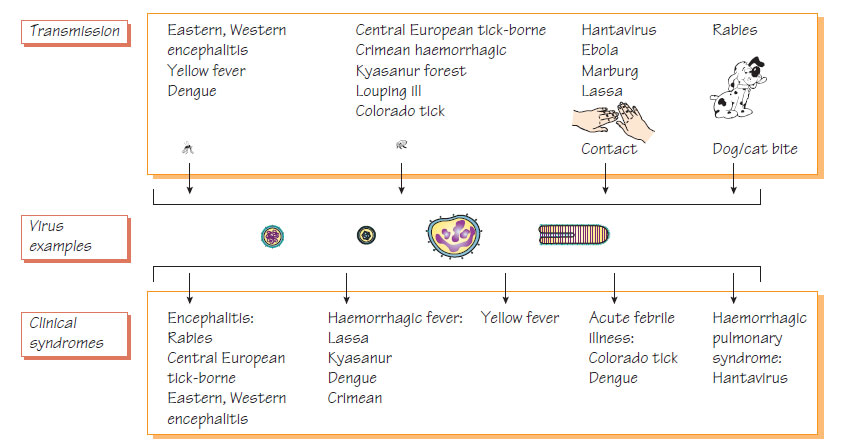Tropical, exotic or arbovirus infections
More than 100 viruses can cause encephalitis or haemorrhagic fever. Almost all are zoonoses, where the human is an accidental host that has come into contact with the natural life cycle. They are transmitted by direct contact with blood and body fluids or by the bite of arthropods, such as mosquitoes, ticks and sandflies. Some infections are associated with a high mortality.Rabies is a rhabdovirus infection that, once symptoms develop, causes a fatal encephalomyelitis.
- It is a bullet-shaped, negative-sense RNA enveloped virus.
- It infects warm-blooded animals worldwide.
- The virus is found in saliva and is transmitted to humans through the bite of an infected animal.
- Two epidemiological patterns exist: urban rabies, which is transmitted by feral and domestic dogs; and sylvatic rabies, which is endemic in small carnivores in the countryside. Dog-bites are responsible for most infections.
- Bats, raccoons and skunks are an important reservoir and vector of infection in the Americas; the red fox is the reservoir of infection in Europe.
- The virus enters via the motor endplates, spreading up the axons to enter the brain. Sites with short neural connections to the central nervous system have the shortest incubation period (7 days), whereas a bite on the foot may have an incubation period of 100 days.
- Bite depth and viral inoculum also influence the incubation period.
Disease is progressive and inevitably fatal. Diagnosis is based on the clinical and epidemiological features, confirmed by specific fluorescence in corneal scrapings, by brain biopsy, or by the finding specific rabies antibody.
The disease may be prevented by pre-exposure vaccination, wound care, local antiserum, systemic hyperimmunoglobulin and a postexposure vaccination course with the human diploid cell vaccine. Preexposure vaccination is reserved for those in a high-risk group (e.g. vets and travellers to remote regions of endemic countries).
Yellow fever virus is a flavivirus, an enveloped positive-sense RNA virus, transmitted by Aedes aegypti. Yellow fever is a zoonosis in which humans are an accidental host (sylvatic disease), but an urban cycle results in periodic human epidemics.
Clinical features
- Infection may be asymptomatic or may cause acute hepatitis and death from hepatic necrosis.
- A short incubation period is followed by fever, nausea and vomiting, and later by jaundice.
- Haemorrhagic manifestations may develop and vomitus may be black because of digested blood (vomito negro).
- The mortality rate is high, but patients who recover do so completely.
- Dengue is a flavivirus related to yellow fever virus with four serotypes.
- It is transmitted by Aedes mosquitos.
- The incubation period is 2-15 days.
- It is found throughout the tropics and the Middle East.
- Epidemics occur when a new serotype enters the community or a large number of susceptible individuals move into an endemic area. Urban epidemics can be explosive and severe.
- Common features include a sudden onset of fever and chills, and headache with pains in the bones and joints. The fever may be biphasic and a mild rash may also be present.
- Dengue haemorrhagic syndrome causes severe shock and bleeding with mortality of 5-10%.
- Diagnosis is by NAAT, serology or culture.
- Prevention is by mosquito control.
- Treatment is symptomatic.
- This is a mosquito-borne flavivirus infection that causes encephalitis with a high mortality.
- The natural reservoir is in pigs.
- It causes abrupt-onset fever and severe headache, nausea and vomiting. Convulsions can occur.
- There may be permanent cranial nerve or pyramidal tract damage.
- Prevention is by vaccination.
West Nile virus
This is a flavivirus infection from Africa, which has been found in North America since 1999 and has spread across the continent into Canada, Latin America and the Caribbean, that causes an encephalitis-like syndrome.
Lassa fever
- Lassa fever is a severe haemorrhagic fever caused by an arenavirus.
- It is endemic in West Africa.
- It is transmitted from house rats to humans and from person to person by contact.
- Patients present with fever, mouth ulcers, myalgia and haemorrhagic rash.
- Diagnosis is clinical and depends on exposure history.
- Confirmation is by NAAT or serology.
- Ribavirin improves outcome if given early and may be given as postexposure prophylaxis to contacts.
- Special isolation is required in hospital.
- These viruses are found in Africa and are transmitted to humans from primates or from a rodent reservoir.
- They cause haemorrhagic disease with high fever and mortality.
- They may be transmitted in the hospital environment.
- Treatment is supportive and with hyperimmune serum.
- Control is not possible as the reservoir is not confirmed.
- Special isolation is required in hospital.
- A vaccine using vesicular stomatitis virus encoding Ebola and Marburg antigens is in development.
Hantavirus
This bunyavirus infection is transmitted to humans from rodents and causes either a haemorrhagic fever with renal failure or hantavirus pulmonary syndrome. The disease occurs widely throughout the world. Person-to-person spread does not appear to take place. The incubation period is 2-3 weeks, followed by fever, headache, backache and injected conjunctiva and palate. Hypotension, shock and oliguric renal failure follow. The mortality rate is about 5%. Diagnosis is based on NAAT, serology and culture.
Nipah virus, a paramyxovirus, causes severe disease in humans and animals. It is found in South Asia and causes febrile encephalitis with a high mortality rate. The reservoir is probably fruit bats, with human infection from contact with bats or an intermediate animal host such as pigs. Person-to-person spread occurs. The related, rarer Hendra virus is also acquired from bats and causes an influenza-like syndrome or encephalitis.





